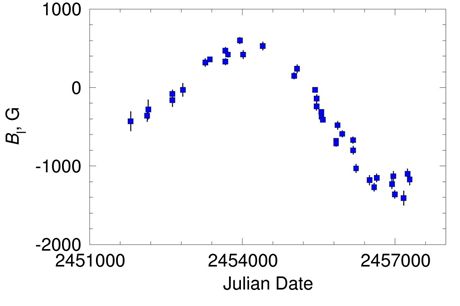|
The chemically peculiar star HD965 belongs to a rare type of very slow
rotators. As far back as in the 90s, G.Mathys (ESO, Chile) supposed its
extremely slow rotation as observing split Zeeman components in the
spectrum, from which he measured the magnetic field on its surface. Field
variation proved to be very slow, and G.Mathys determined that the
variability period should be longer than two years.
In 1999, at G.Wade's suggestion, HD965 was included in the joint program of
magnetic field observations with the SAO RAS 6-m telescope (BTA). First
results of the observations were published in 2005 (Elkin et al., 2005,
MNRAS, 358, 1100). Magnetic monitoring of HD 965 had been carried out on the
BTA in the period from 2000 to 2015 with the
Main Stellar Spectrograph.
Our 15-year observations showed that the positive extremum of the star's
longitudinal magnetic field (+600 Gs) was observed in 2005, and the negative
one (-1300 Gs) in summer 2015. Thus, our observations have not covered the
entire rotation period of the star, although there are strong reasons to
consider it to be equal to about 20 years. Up to now, only two stars with
periods longer than 20 years are known. Those are γ Equ with a
period of about 100 years, and HD9996 - 21-22 years. HD965 so far ranks
third in the period length among all (about 300) magnetic CP stars with
determined or estimated rotation periods.
Detection of another magnetic star with a rotation period of more than 20
years is indicative of the fact that ultra slow rotation is very rare but
not unique. We obtained one more argument for the fossil origin of the
magnetic field in CP stars. As already three very slow rotators have been
found, we can draw a conclusion that magnetic fields greater than 1 kGs can
also form in such objects, which in turn proves that the field formation
mechanism is not associated with rotation. Different dynamo mechanisms fail
to effectively generate strong global magnetic fields of chemically peculiar
stars during their Main Sequence (MS) lifetime. Global magnetic fields form
with a star itself, before it enters the MS stage. There is no magnetic
field generation but only a very slow, gradual fading (at timescale of
billions of years) and simplification of the magnetic field structure during
the MS lifetime of the star.
Published:
I.I.Romanyuk, D.O.Kudryavtsev, E.A.Semenko, and I.A.Yakunin,
"Magnetic Field Monitoring of the Very Slowly Rotating CP Star HD 965",
2015, Astrophysical Bulletin, 70, 456
Contact - I.I.Romanyuk

Fig.1.
Longitudinal magnetic field curve of the CP star HD965 in the time
interval from 2000 to 2015. The blue squares are the measurements from the
shift of oppositely circularly polarized Zeeman components
|


